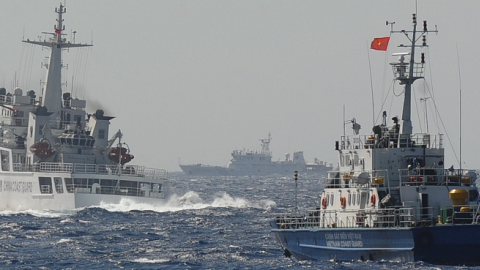Much has already been written about the ongoing crisis near the disputed Paracel Islands in the South China Sea between China and Vietnam, and as it worsens, much more will be penned on this issue. The blessing of geography offers Australia some strategic distance and therefore strategic depth and comfort from possible turmoil in East Asia. But we are hardly immune. Around two-thirds of Australian exports and half of its imports traverse through the South China Sea alone. And if recent trends are anything to go by, these crises are probably going to get even more frequent and less manageable. This means that we will not be able to stay on the sidelines -- diplomatically at least -- into the future.
First a recap... Earlier in the month, state-owned China National Offshore Oil Corporation moved its advanced Hai Yang Shi You 981 deep sea oil-rig southward into the South China Sea into Mining Block 143 only 120 nautical miles from Vietnam’s shore. Located well within Vietnam’s continental shelf and Exclusive Economic Zone as defined by the United Nations Convention on the Law of the Sea, a reported 80 Chinese vessels, including seven armed People’s Liberation Army Navy ships in addition to coastguard vessels were sent to accompany and protect the HYSY 981 operation. In response, Vietnam dispatched its own coast guard vessels to confront the Chinese flotilla, leading to the use of water cannons against Vietnamese ships and several collisions within the 3 nautical mile zone around the rig.
In Vietnam, the government first tolerated then clamped down on protests against the Chinese action after a number of people were killed, with reports suggesting that more than a dozen people ‘of Chinese appearance’ were dead or missing. Meanwhile, as China sent ships to evacuate thousands of citizens from Vietnam, Beijing has set up a 10km protection zone around the oil-rig, further enraging Vietnamese protesters. This is clearly the worst turn in Sino-Vietnam relations since their war in 1979.
Although the disputes over sovereignty and control in parts of the South China Sea have gone on for decades, the current incident did more than raise eyebrows for a number of other reasons.
First, the Chinese action to relocate the oil-rig within Vietnam’s EEZ occurred at a time when bilateral relations between the two countries seem to have stabilised for the better -- unlike China’s relationship with the Philippines and Japan. It was therefore unexpected that this was the first time that China had actually placed an oil rig in the EEZ of another claimant state in the South China Sea, and that China chose to do so in Vietnam’s EEZ.
Second, the size of the Chinese flotilla suggests a high degree of planning and coordination between various central and local government entities and agencies. Moreover, the apparent involvement of the PLAN and not just the coastguard and other paramilitary organisations, which if confirmed, would involve a new level of Chinese militarisation of maritime disputes.
Third, the fact that the HYSY 981 oil-rig belonged to CNOOC is highly significant. As one of the country’s leading ‘national champions’ in a designated ‘strategic sector’ considered essential to the country’s current and future national interest, CNOOC receives considerable governmental largesse in the form of diplomatic, financial, regulatory and other support. In return, the institutional and personnel links between CNOOC and the Chinese Communist Party are extensive and deep. It would be unthinkable that the relocation of HYSY 981 to a block within Vietnam’s EEZ could have occurred without approval and knowledge of political officials at the highest levels of government.
When taken together, these factors mean that the HYSY 981 episode serves as a portentous development for countries with sovereign and maritime disputes with China in East Asia: Japan, Vietnam, the Philippines, Malaysia, Brunei and Indonesia. Even if one cannot be sure whether Beijing ordered CNOOC to relocate the oil rig to Mining Block 143, there is enough evidence to believe that the move was at least supported at the highest levels of the Chinese government.
Moreover, even if such large-scale, coordinated and provocative Chinese actions remain relatively rare into the future compared to smaller scale and less coordinated manoeuvres, any moves need to be understood within a broader background of increased Chinese stridency in pursuing maritime and sovereign claims in both the East China and South China Seas since around 2010 (allowing for slight lulls in frequency of alleged incursions and tension during some periods.) Indeed, and putting aside the issues in the Korean peninsula, assertive Chinese maritime policy and behaviour has become the primary regional concern for the United States, which has treaty obligations to Japan and the Philippines, and for small maritime states such as Singapore.
Back to Australian interests and concerns. The importance of stability and free and open access to the sea-lines-of-communications to Australia’s north was explicitly recognised as one of the key national strategic objectives in the 2000 Defence White Paper, and was reaffirmed in the 2009 and 2013 White Papers. Such a key objective would be compromised by claimant states, especially great powers, using force and other forms of coercion to pursue their claims in the East and South China Seas, and by any significant change to the boundaries of the maritime commons -- or guaranteed free and open access to these commons -- established since the end of the Second World War.
Putting this another way: if there is a powerful developer wanting to claim ownership of the easement just in front of our driveway, would we really consider it none of our business to voice an opinion on how things should be managed? Would we really just rely on reassurances that access to the easement, after it is possessed by the developer, will continued as before? The area around the Paracel Islands only concern one part of the South China Sea. But China is deliberately vague about its claims which include almost all of the South China Sea, under what rationale these claims are made, and where its priorities lie. It is no wonder that regional countries feel that to concede a small area to China will the first step in eventually conceding a much larger one.
This puts Australia in a bind. Our government has usually taken a low-profile, and even passive, approach vis-à-vis these disputes. There have been exceptions. One occurred when Foreign Minister Julie Bishop took the unusually forthright decision to summon the Chinese Ambassador to voice Australian complaints about China establishing an Air Defence Identification Zone over contested areas of the East China Sea in November 2013, having stated that Australia “opposed any coercive or unilateral actions that could change the status quo in the East China Sea.”
But this is an exception. In general, we have avoided criticising China for fear of offending our largest trading partner. Such an approach is understandable since Australia can do little to actually solve the dispute, or alter the military balance in East Asia. In other words, our passivity is largely explained by the fact that we seem to have no skin in the game, or any real leverage to speak of.
Yet, is our silence part of the problem? After all, Chinese claims in the East and South China Seas, and behaviour in making good on these claims, put it directly at odds with Japan, Vietnam, the Philippines, Indonesia, Malaysia and Brunei. Maritime countries such as Singapore who depend on free, open and guaranteed access to SLOCs are deeply uncomfortable with what China is doing, as is America. A large part of China’s diplomatic strategy is to convince countries, other than the one it is having a dispute with at any given time, that they should mind their own business, not comment on what Beijing insists is a ‘bilateral dispute’ even as the interests of other states are deeply affected. And the more ‘third parties’ mind their own business, the bolder and more emboldened Beijing seems to become.
So even if we have excellent diplomatic relations with China, its growing claims and increasingly assertive behaviour in East Asia will detrimentally affect our interests. It is likely that things in East Asia involving China will get worse, and there is no guarantee they will eventually get better, even if actual conflict is avoided.
Making ourselves a ‘small-target’ and doing nothing is less and less an option. It is time to have awkward conversations with China. But we’re hardly alone. Every other maritime country in Asia will be forced to do the same as well.
















